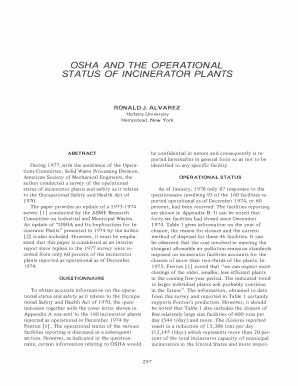
Get Osha And The Operational Status Of Incinerator Plants
How it works
-
Open form follow the instructions
-
Easily sign the form with your finger
-
Send filled & signed form or save
How to fill out the Osha And The Operational Status Of Incinerator Plants online
This guide provides a comprehensive overview of how to complete the Osha And The Operational Status Of Incinerator Plants form online. By following the steps outlined below, users can ensure that they accurately fill out the necessary information related to the operational status and safety compliance of incinerator facilities.
Follow the steps to complete the form effectively.
- Use the ‘Get Form’ button to access the form needed for submission. This action will open the document and allow you to begin filling it out.
- Provide the name and address of the facility. This section requires you to detail the name of the operational plant, along with its street, city, state, county, and zip code.
- Identify the individual completing the questionnaire by filling out their name, position or title, and telephone number. Ensuring this information is accurate is essential for follow-up.
- Answer the operational status questions. Indicate if the facility is operational or temporarily/permanently closed. If closed, provide the date of closure and the reason for it.
- Fill in the safety compliance section. Here, specify whether the state has an OSHA plan in place for the facility. Also, indicate personal familiarity with OSHA provisions and whether employees have been instructed in these standards.
- Respond to questions regarding past inspections by OSHA compliance officers. If inspected, disclose whether any citations were issued and the nature of those citations.
- Review your responses for accuracy and completeness. It is vital to ensure all necessary fields are filled out appropriately before submission.
- Finalize your submission. Depending on the online system, you may have the option to save changes, download, print, or share your filled-out form.
Start completing your document online to ensure compliance with OSHA regulations.
OSHA's Hazardous Waste Operations and Emergency Response (HAZWOPER) standard outlines the regulations for workers handling hazardous waste, including incinerator plants. This standard aims to ensure the safety and health of employees in hazardous waste operations, including waste treatment and disposal facilities. Understanding this section is essential for compliance and maintaining the operational status of incinerator plants while adhering to OSHA guidelines. If you're looking for more information, uslegalforms can provide helpful resources.
Industry-leading security and compliance
-
In businnes since 199725+ years providing professional legal documents.
-
Accredited businessGuarantees that a business meets BBB accreditation standards in the US and Canada.
-
Secured by BraintreeValidated Level 1 PCI DSS compliant payment gateway that accepts most major credit and debit card brands from across the globe.


